The Perfect NO BAKE Easy Vegan Sponge Cake Recipe.
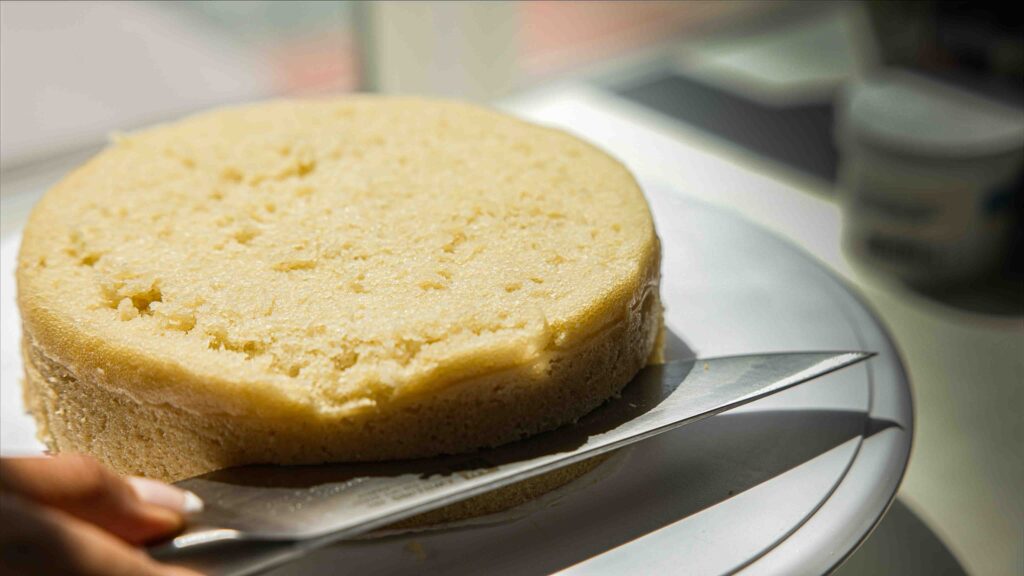
Light. Fluffy. Vegan.
Sponge cake.
I have been pursuing the PERFECT vegan sponge cake since I went vegan back in 2016.
That’s EIGHT YEARS.
I’ve baked more so-called vegan sponge recipes than you ever want to know. And it turns out, that was my mistake:
BAKING.
Wanna know more?
Let’s get into it!
- What Is A Sponge Cake And How Is It Different From Regular Cakes?
- Why We Need A Better Vegan Sponge Cake Recipe.
- But How Is This A "No Bake" Vegan Sponge Cake?
- Special Equipment For Making Steamed Vegan Sponge Cake.
- Key Ingredients And Notes On Substitutions For Vegan Sponge Cake.
- How To Make Vegan Sponge Cake.
- A Word On Frosting Your Vegan Sponge Cake.
- Frequently Asked Questions.
- Recipe Card
- Questions & Comments
Disclaimer: Some of the links in this post may be affiliate links for products I use and love. If you make a purchase after clicking one of those links, I may earn a small affiliate commission, perhaps enough to buy some extra gochujang or gochugaru 🙂
What Is A Sponge Cake And How Is It Different From Regular Cakes?
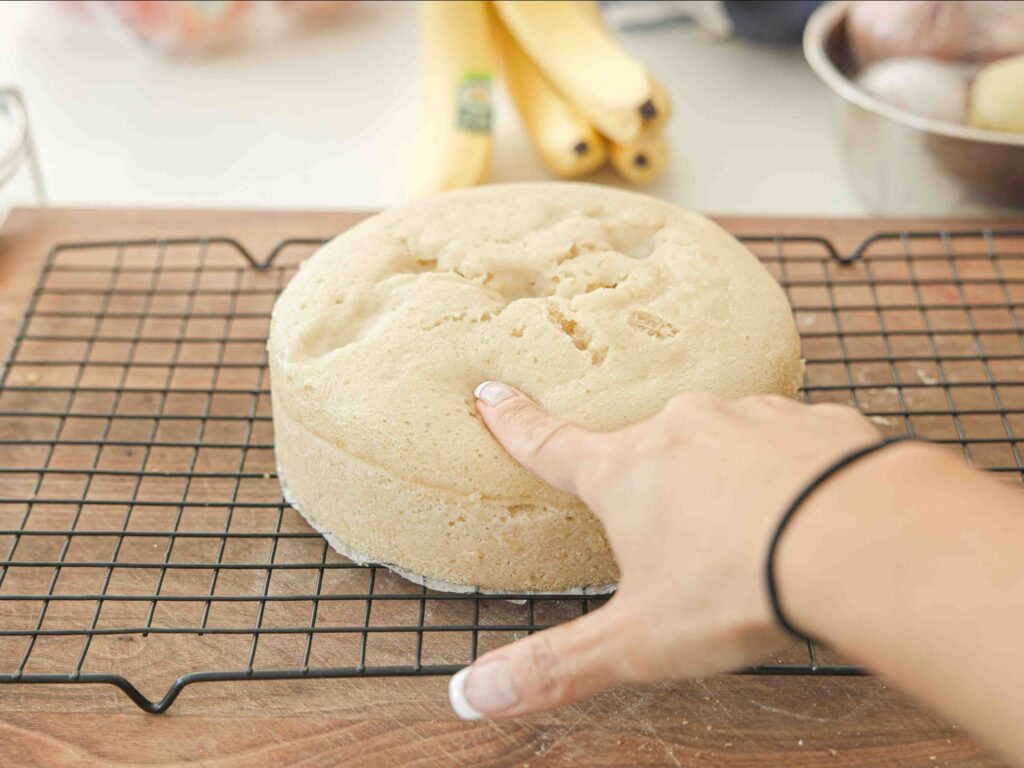
Generally speaking, there are two different kinds of cakes:
Butter cakes and foam cakes.
Butter cakes, as the name suggests, incorporate substantial sources of fat–like butter! Or margarine or vegetable shortening. Pound cake, for example, is a good example of a butter cake. Butter cakes tend to be richer, denser, and quite moist. Foam cakes, on the other hand, have no or little fat. What fat they do contain, moreover, is usually from eggs. They are lighter and fluffier and more delicate. They are therefore often decorated with a lighter frosting (like whipped cream).
As you can probably guess, a sponge cake falls into the latter category (with the exception of the Victoria sponge, which includes butter). Traditionally, the sponge cake relies on beaten eggs alone or supplemented with baking powder in order to achieve aeration and rise.
Why We Need A Better Vegan Sponge Cake Recipe.
I was at my father’s 80th birthday party a couple months ago and fell completely enamored with the beautiful, Korean style bakery cake my mother had custom made for the special occasion. Of course, it wasn’t vegan so I couldn’t partake. Instead, I munched on a very terrible, very dry vegan chocolate chip cookie (it remains one of the great mysteries that restaurants can’t make better vegan desserts when the internet is full of free vegan cake recipes).
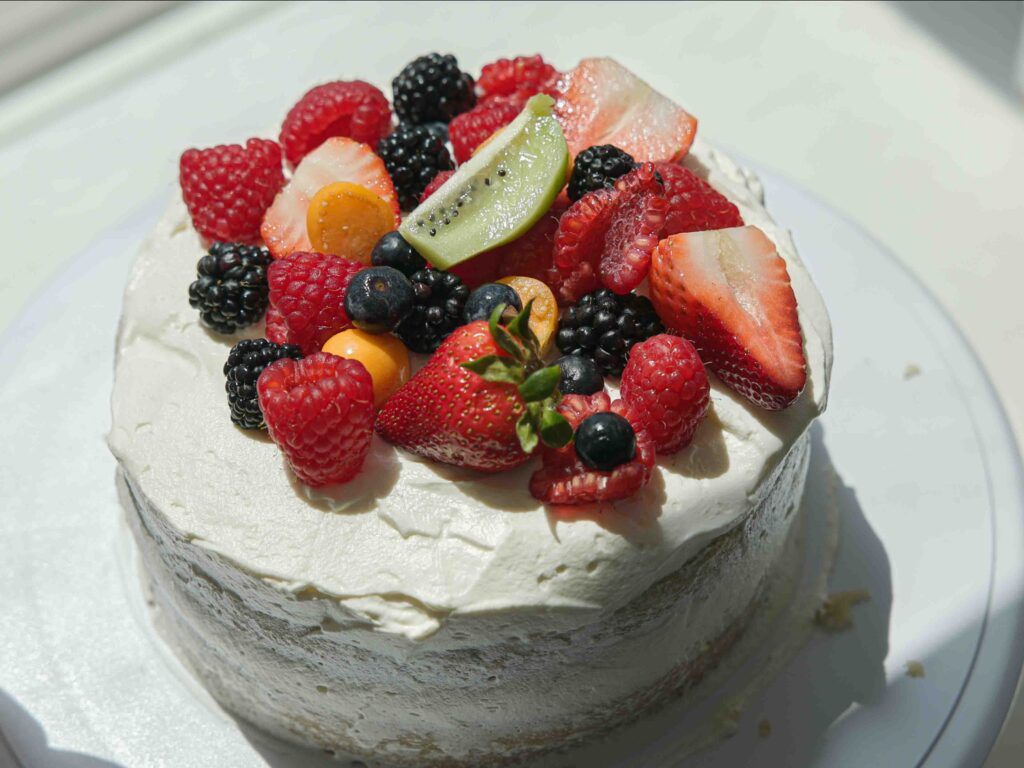
I haven’t had a Korean style bakery cake since going vegan. Why? Korean bakery cakes start with a light, fluffy sponge. But vegan sponge cakes are not truly “sponge-y.” Without eggs, most vegan sponge cakes lack the structure and protein to achieve sufficient aeration and good rise.
But not THIS vegan sponge cake!
I was absolutely determined to perfect the vegan sponge cake so that I could make the perfect vegan birthday cake–for moi.
You see, I’m turning 45 tomorrow and I simply refuse to celebrate without my Korean style bakery cake, made up of perfectly fluffy cakes, sandwiching fresh strawberries, and topped with whipped cream frosting and a cornucopia of fresh fruit.
But How Is This A “No Bake” Vegan Sponge Cake?
Many years ago, a good friend and fellow vegan recipe developer and cookbook author, Sheil Shukla, invited me and my husband over to his house for dinner. Sheil’s family hails from Gujarat, a region of India that is largely vegetarian. Among the many delicious Indian delicacies he and his wife prepared for us was a light, fluffy, savory cake made out of chickpea flour. I’ve since learned that these are called khaman dokla.
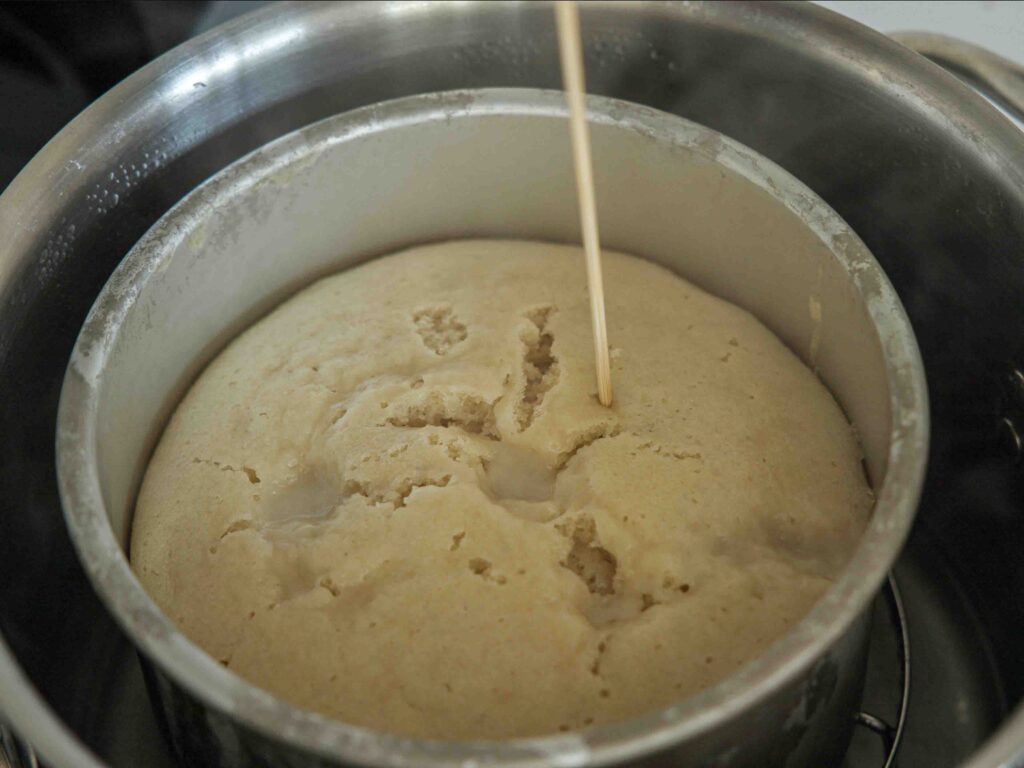
I marveled at the airy texture. He explained that the cake was steamed instead of baked. A lightbulb went on. Could this be the secret to the perfect vegan sponge cake?
Sadly, I got sidetracked from my pursuit of the perfect vegan sponge cake and for years, settled for what can only be described as vegan butter cakes or really dense vegan cakes (still delicious!) masquerading as vegan sponge cakes.
After having to refuse a slice of my father’s beautiful birthday cake, though, I came back to my kitchen more determined than ever to figure it out. I went deep down a rabbit hole of eggless steamed cakes–most of which were demonstrated or shared by Indian recipe developers and cooks. In some cases, there were no raising agents at all–no baking powder, no baking soda. In other cases, both baking powder and baking soda came into play.
But, in every case–literally every case I could find–there was dairy.
Sometimes it was yogurt. Sometimes it was buttermilk. Sometimes it was just plain milk.
In all my years of tinkering in the kitchen with developing vegan recipes, replacing regular milk with plant-based milk has never caused me any problems. Even when making milk bread! It’s always the eggs or the egg whites that provide the biggest hurdles to vegan desserts.
Accordingly, I had to take a leap of faith and believe that it was the methodology–i.e., the steaming–and not some unique property of dairy that facilitated the glorious “fluff” of these eggless fluffy cakes.
And boy. Did it pay off!
What’s even more awesome is that this recipe is about as uncomplicated as it gets. No need to whip anything to stiff peaks, create ribbons, or do any of those fancy things that used to screw me up when I was little and there were no YouTube videos to explain what “stiff peaks” even means. You’ve got a handful of ingredients that you measure, mix, and steam, and that’s it!
Special Equipment For Making Steamed Vegan Sponge Cake.
You’ll need some of the basic equipment that typically attends cake making: large mixing bowl or two, whisks, spoons, etc. But there are a couple of pieces of equipment that are worth flagging, in case you don’t already have them lying around:
- Tall Round Steam Rack. Every Indian cook I watched making these eggless (but not vegan) steamed cakes used round steam racks that had really tall legs. They would place these inside a much larger pot with about an inch of water (hence the tall legs), which would hold the cake tins above the water. You can find them online.
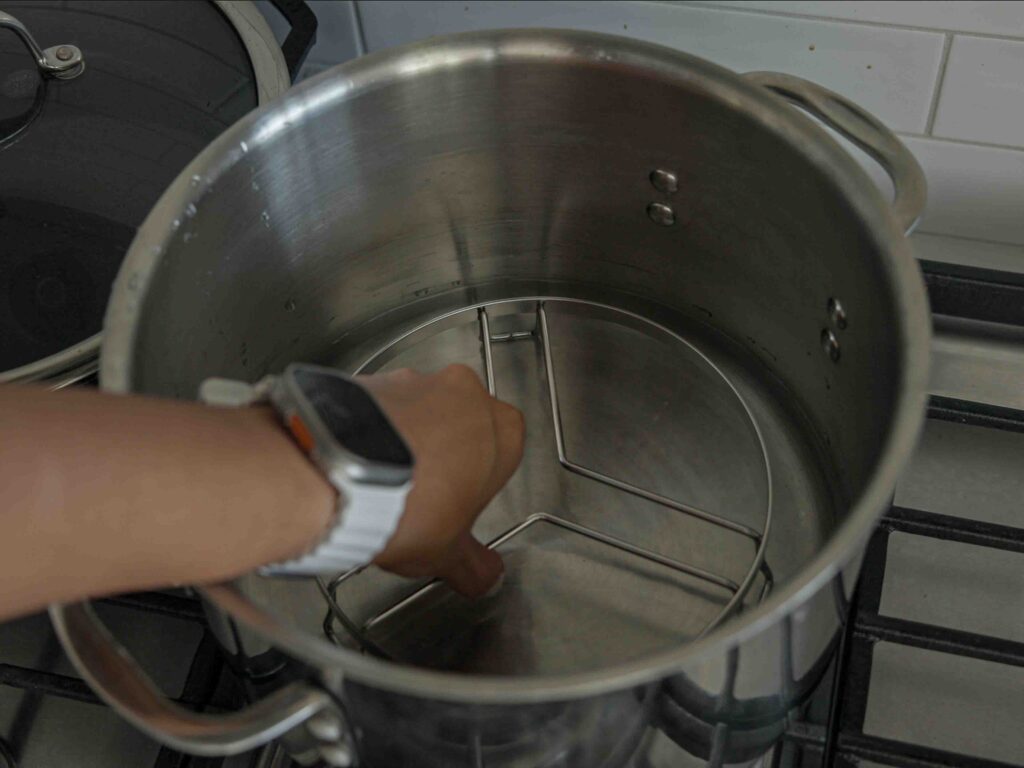
- Deep 6-Inch Round Cake Pans. You’ll need at least one deep 6-inch round cake pan. Why? Because this vegan sponge cake is going to rise! You can find them at your local kitchen equipment shop or online.
- Sifter. The name of the game is “light” which means you’ll need to sift all your dry ingredients. I know you don’t want to, but it’s really important here. I have a really fun sifter that makes sifting not as annoying. You can also just use a fine mesh strainer.
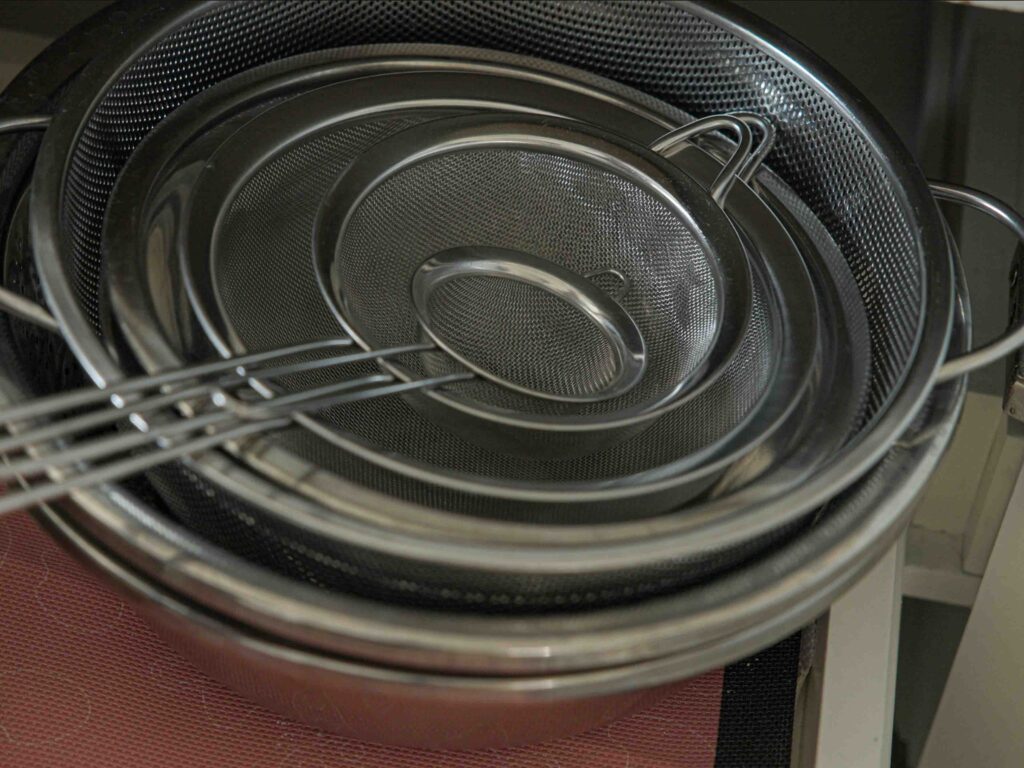
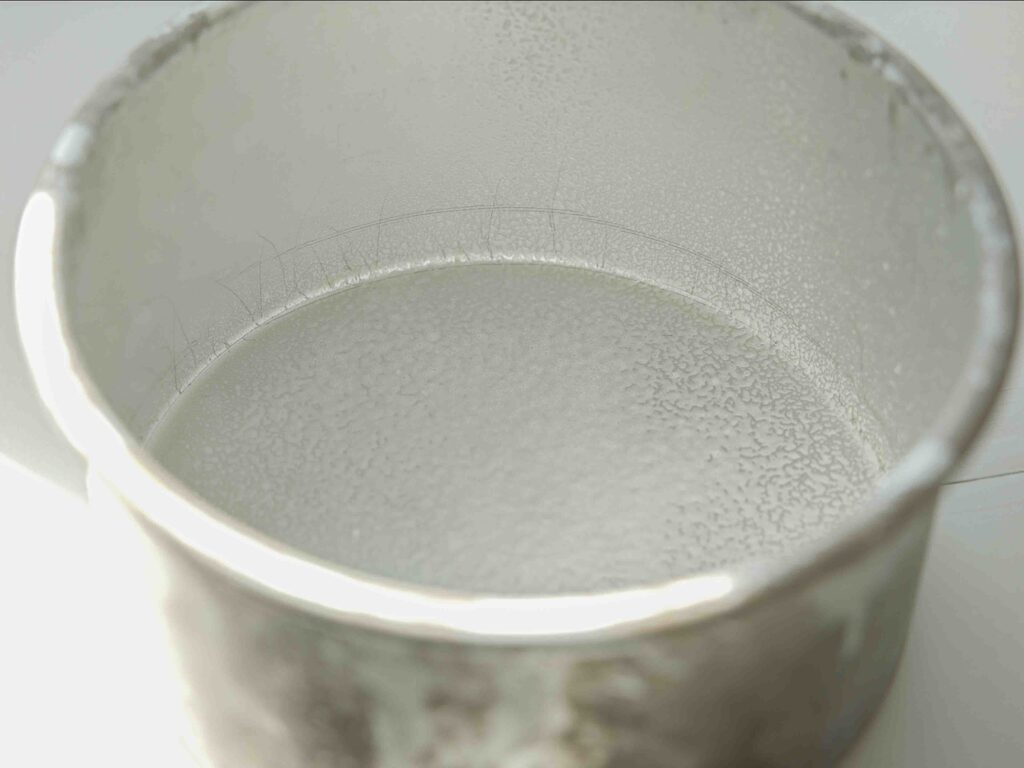
Key Ingredients And Notes On Substitutions For Vegan Sponge Cake.
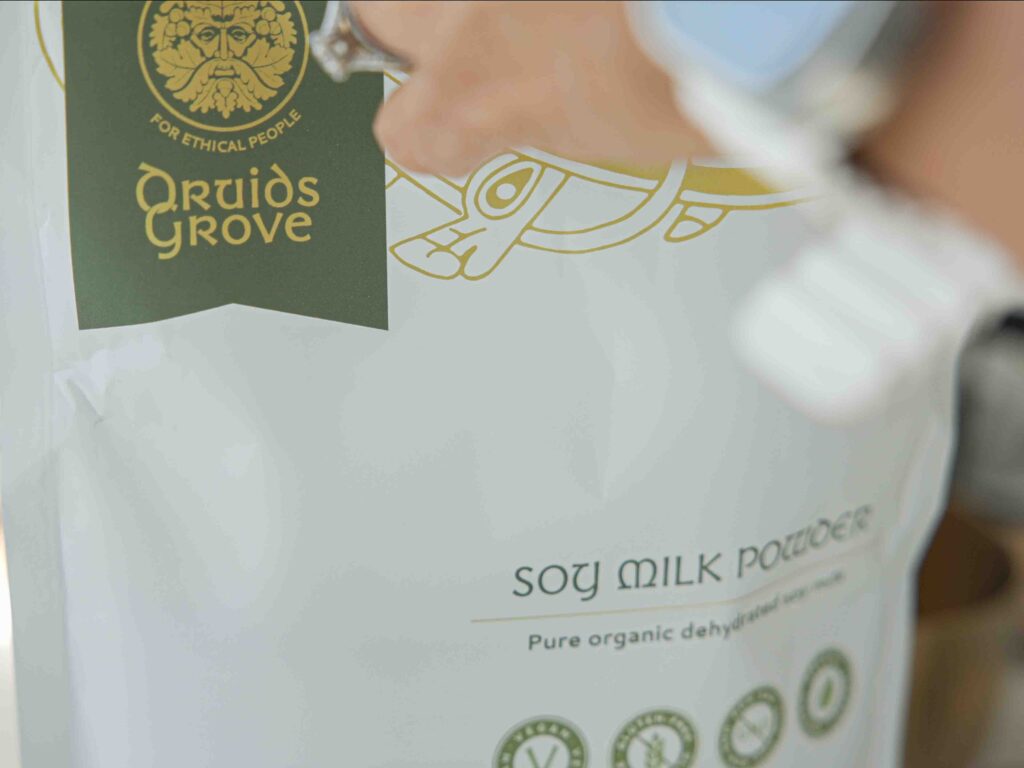
The following are a list of the key ingredients and recommendations on substitutions:
- All Purpose Flour. This vegan sponge cake recipe contains all purpose flour. I would not try using cake flour (which doesn’t have as much protein) or bread flour (which has too much protein). All purpose flour will give you the best results. I know what you’re gonna ask–can you use gluten-free flour? Your favorite gluten-free flour blend will give you a delicious, moist, and likely dense cake. It will not resemble a light, fluffy, sponge cake. But, you can definitely give it a try!
- Raising Agents. Although some of the eggless steamed cake recipes I researched did not include baking powder or baking soda, I decided not to take any risks here and use both. The baking soda, in particular, will react with the vegan buttermilk (soy milk mixed with acid) to create air bubbles that will help provide this vegan sponge cake with a light, airy crumb.
- Soy Milk. In my experience, soy milk is the closest thing to real dairy milk out there. Like dairy milk, soy milk contains a significant amount of protein. This is what allows it to curdle so well (unlike, say, almond milk). If you don’t have or like to use soy milk, you can substitute with oat milk.
- Lemon Juice. As I mentioned above, you will need to create vegan buttermilk by stirring your soy milk with a little lemon juice. If you don’t have a lemon lying around, you can substitute with white vinegar or apple cider vinegar.
- Soy Milk Powder. Milk powder is often used to tenderize baked goods. Here, we replace the dairy milk powder with soy milk powder, which will accomplish the same thing. It will keep your cake tender, bouncy, and moist. You can find soy milk powder online. If you cannot find soy milk powder, you can substitute with oat milk powder.
- Powdered Sugar. In lieu of using granulated sugar, this recipe for vegan sponge cake calls for powdered sugar (aka icing sugar) or, at the very least, caster sugar (aka ultra-fine sugar). Again, the idea is to make the batter as light as possible. Hence, the inclusion of finely milled sugar.
- Vegetable Oil. The traditional sponge cake utilizes fat from the eggs. Here, there are no eggs. Instead, this recipe calls for vegetable oil, which will help keep this cake moist without the heaviness associated with butter or vegetable shortening. You can use any neutral vegetable oil here (peanut oil, sunflower oil, safflower oil, rapeseed oil, avocado oil, etc.).
How To Make Vegan Sponge Cake.
First, prepare your cake pan by spraying it with a little cooking spray and lining it with parchment paper. Then, make your vegan buttermilk by mixing together your soy milk and lemon juice. Set this aside until it curdles (about 10 minutes). Next, sift your dry ingredients (except for the sugar) into a large bowl: all purpose flour, soy milk powder, baking powder, and baking soda. Set this aside.
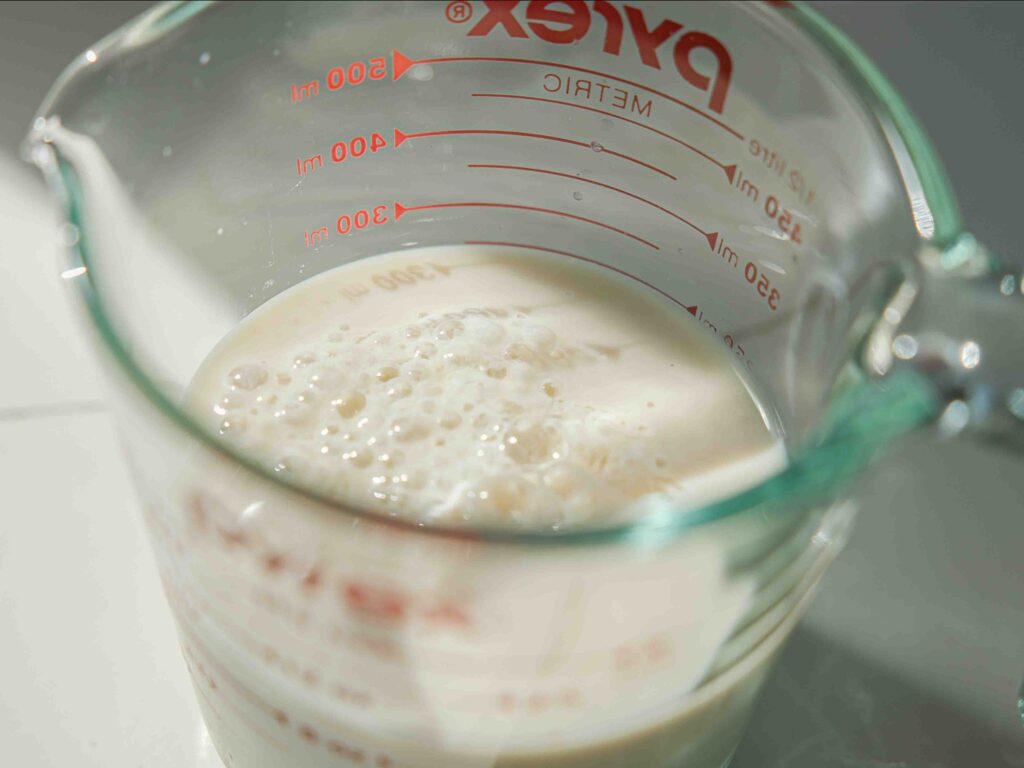
In another large bowl, add your vegan buttermilk, together with the vegetable oil, vanilla extract, and sugar. Whisk for about 7 to 8 minutes, until all the ingredients are smooth and well incorporated. You should not be able to see any separation between the vegan buttermilk and the vegetable oil.
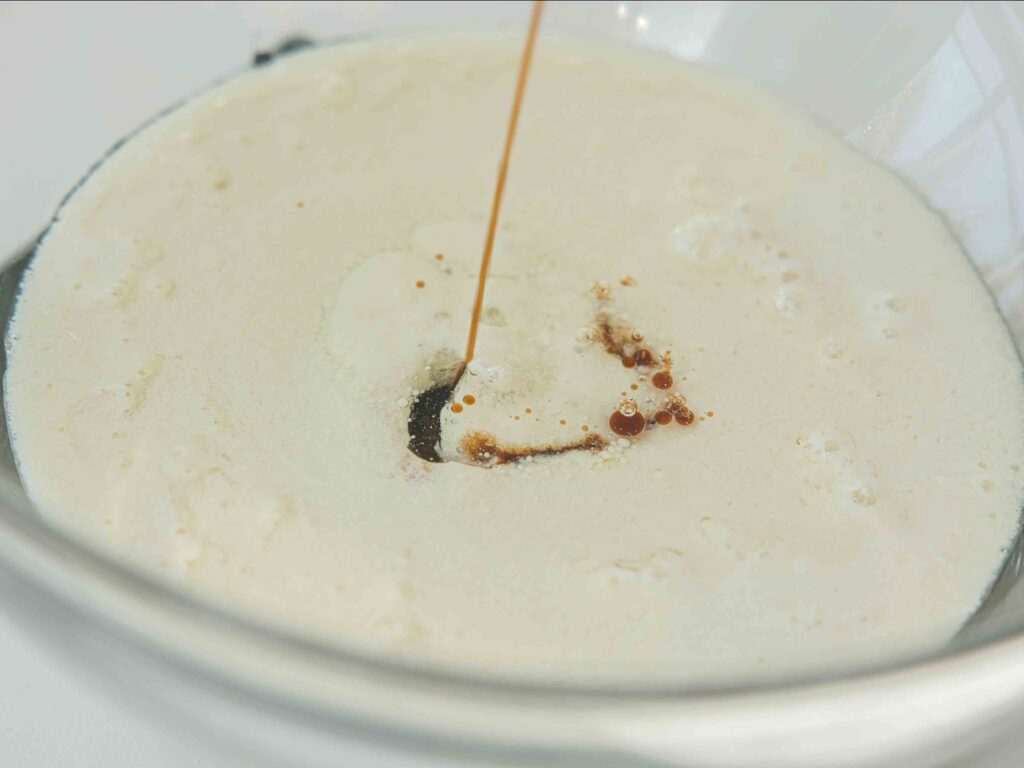
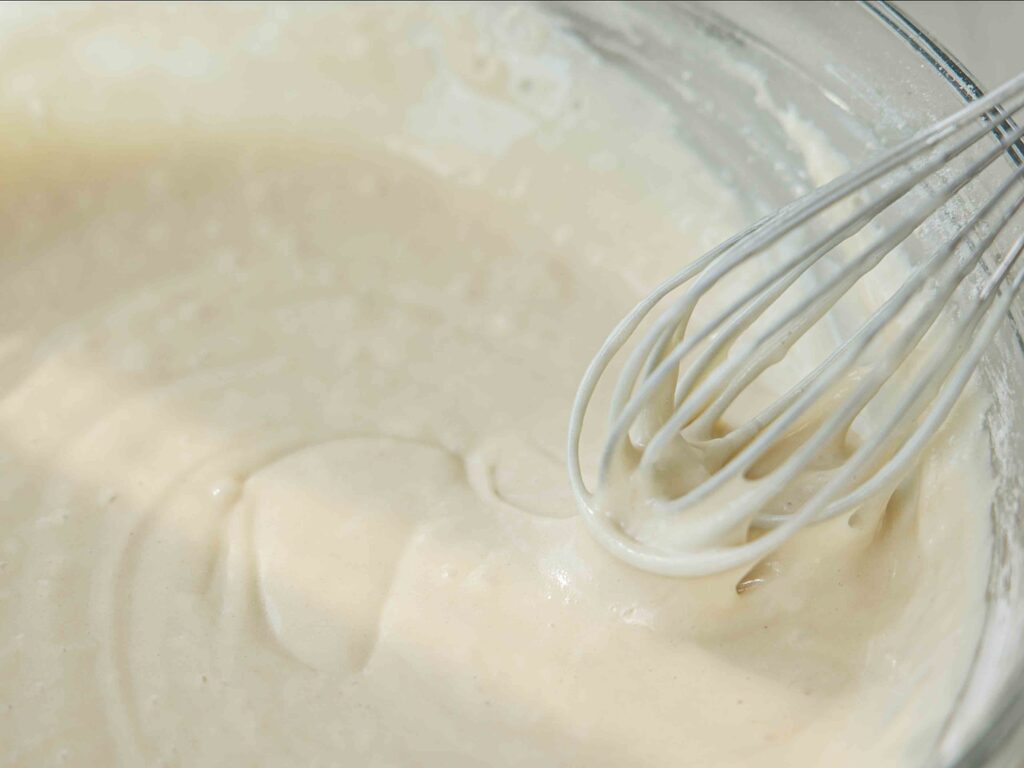
Before you combine your dry ingredients with your wet ingredients, place a large pot (like a stock pot or a pasta pot) with about 1 inch of water on the stovetop over medium high heat. Place the steam rack inside the pot. You’ll want your water boiling by the time you’ve prepared the batter, because the longer the batter has to sit outside the steam, the more likely it will deflate.
To finish making the batter, add your dry ingredients to your wet ingredients in four parts and through a sifter or fine mesh strainer (that’s right–you’re going to double sift!). Make sure that you mix the dry ingredients until all the flour is well incorporated before adding more. Doing this in parts will guard against over-mixing. Once all the flour mixture has been mixed into the batter, top it off with a little more dairy-free milk. Whisk until you have a silky smooth batter.
Pour the batter into your cake pan. Then, gently place it atop the steam rack in the pot of boiling water. Cover the pot with a lid and let the cake steam for 5 minutes over medium heat. Then, reduce the heat to as low as it will go and steam for another 40 to 45 minutes. To test whether your cake is done, insert a large wooden skewer or toothpick into the center of your cake. If it comes out without any wet gook on it, your cake is done cooking!
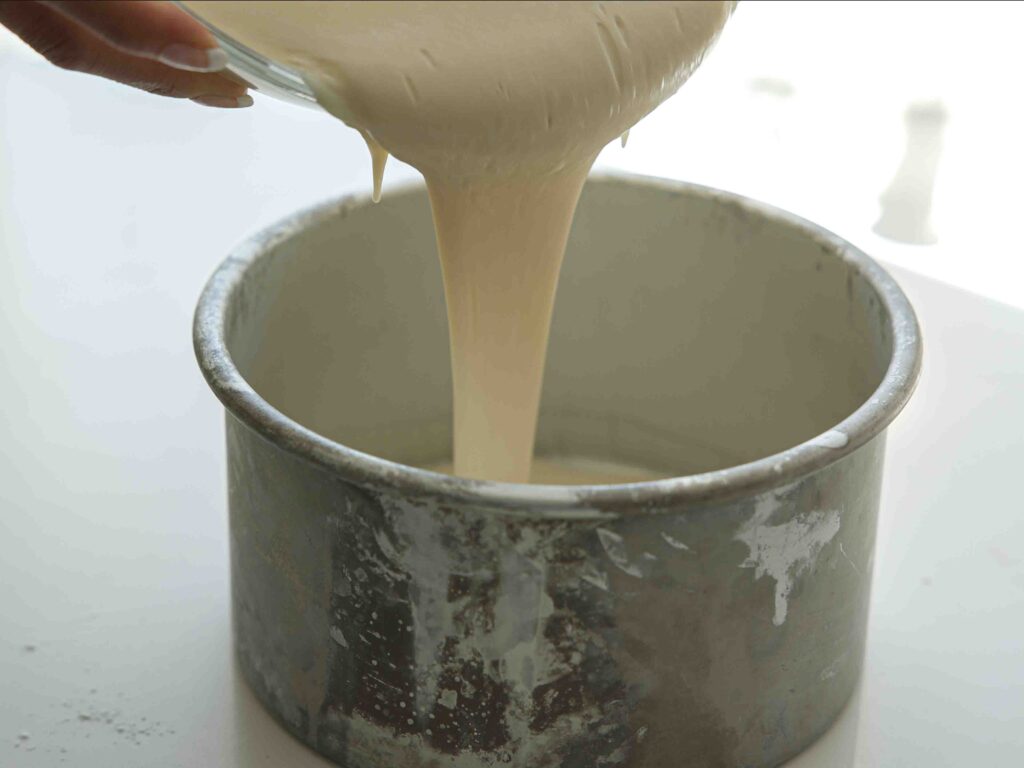
Place your cake, still in the tin, on your wire rack. Let it cool for about 10 minutes. Then, using a sharp knife or offset spatula, gently loosen the cake from your cake pan. Place a plate over the top and flip your cake pan upside down, allowing gravity to do the rest. To get your cake right side up, sandwich your cake gently between the plate and your wire rack and flip once more.

Voila! Perfect vegan sponge cake!
Tip: Wrap the lid of your pot in a kitchen towel to avoid condensation dripping into your cake!
A Word On Frosting Your Vegan Sponge Cake.
You can absolutely create two layers of vegan sponge cake with this recipe. Just make sure to do a better job of creating even layers than I did! The sponge is fragile, though, so make sure to use a very sharp knife.
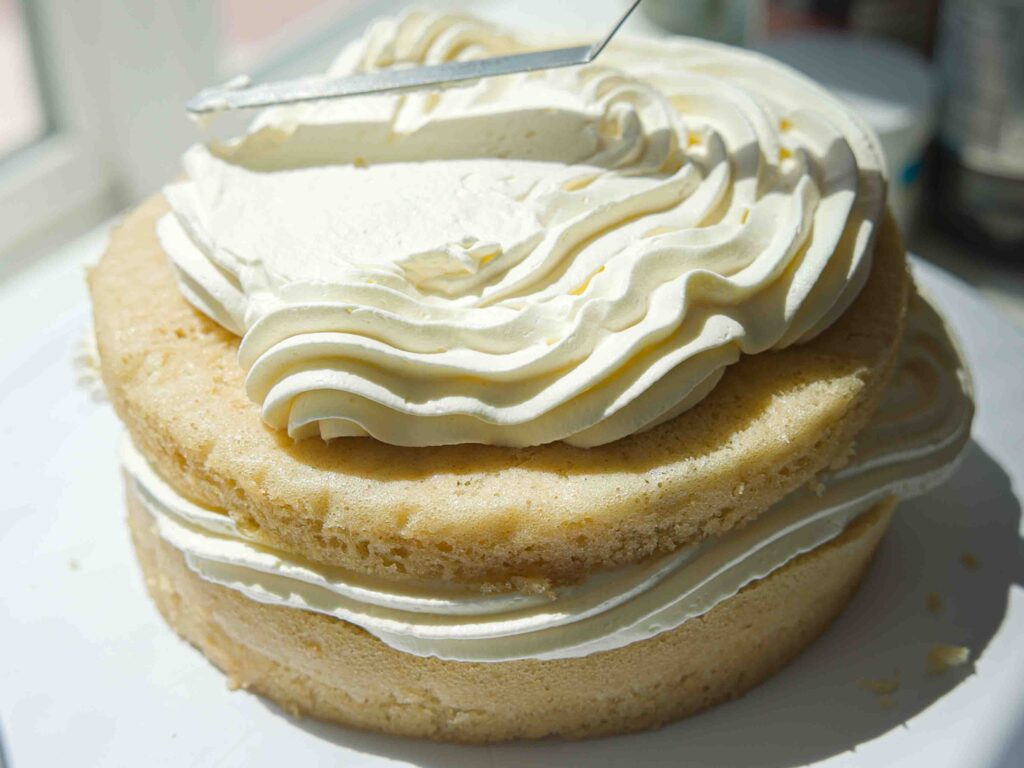
Also, because sponge cakes (traditional or vegan) are lighter cakes, you do not want to frost with a vegan buttercream frosting here. Such a heavy topping would weigh the cakes down and risk breaking them. Instead, use a light whipped cream frosting or even just an icing or a chocolate ganache. You can also just use some fruit jam or preserves and dust the top with powdered sugar.
I went a little overboard with the fresh fruit on my Korean style birthday cake and neither my vegan whipped cream nor my vegan sponge cake could withstand the weight of that aforementioned cornucopia. So, just a word to the wise–go easy on the toppings!
Frequently Asked Questions.
What can I use in a sponge cake instead of eggs?
Many sponge cake recipes utilize both eggs and baking powder. But if you are looking for a completely eggless sponge cake recipe, you can use baking powder, baking soda, and some kind of acid (e.g., vegan buttermilk) to react with the baking soda and achieve the aeration and rise of a traditional sponge.
Why does steaming work better than baking for a vegan sponge cake?
Steaming provides a much gentler and slower heat for your sponge to cook in than baking, allowing for the gradual development of structure and air pockets that will keep the cake fluffy, light, and moist.
Can you make the vegan sponge cake in advance?
Yes. You can make the vegan sponge cake in advance, wrap it in plastic wrap or place it in an airtight cake holder, and store it in the refrigerator for up to 24 hours.
Recipe Card
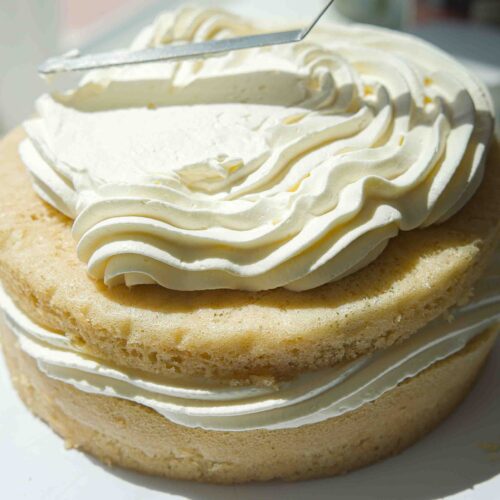
Easy No Bake Vegan Sponge Cake
Equipment
- 1 round steam rack
- 1 sifter or medium fine mesh strainer
Ingredients
- 1 1/3 cup soy milk, divided into 1 cup and 1/3 cup
- 1 tbsp lemon juice
- 1 1/2 cup all purpose flour
- 2 tbsp soy milk powder
- 2 tsp baking powder
- 3/4 tsp baking soda
- 1/2 cup vegetable oil
- 1 cup powdered sugar
- 1 tbsp vanilla extract
Instructions
- Prepare your cake pan by spraying it with cooking spray and lining the bottom with parchment paper.
- Make your vegan buttermilk by mixing together 1 cup of soy milk with lemon juice. Set this aside until it curdles (about 10 minutes).
- Into a large bowl, sift your flour, soy milk powder, baking powder, and baking soda. Whisk the ingredients together. Set this aside.
- In a separate large bowl, whisk together the vegan buttermilk, vegetable oil, powdered sugar, and vanilla extract until well combined and you cannot see any visible separation between the vegan buttermilk and the oil. This will take about 7 to 8 minutes.
- Before adding your dry ingredients to your wet ingredients, place a large pot with about 1 inch of water over medium high heat. Place the steam rack inside the pot. Make sure your water is boiling before you complete making your batter, as you will want to place your batter into the steam as soon as it is fully mixed.
- To finish making your batter, into the large bowl of wet ingredients, sift your dry ingredients in four parts. In other words, incorporate your dry ingredients a quarter at a time. Make sure the flour blend is fully mixed in before adding more. Once all your dry ingredients have been incorporated, add 1/3 cup of soy milk and whisk until you have a smooth batter.
- Pour your batter into your cake pan and place the cake pan on top of the steam rack. Cover the pot with a lid and let the cake steam for about 5 minutes over medium heat. Then, reduce the heat to as low as it will go and steam for an additional 40 to 45 minutes, until a wooden skewer or toothpick inserted into the center of the cake comes out clean.
- Let your cake cool inside your cake pan on a wire rack for about 10 minutes. Then, run a sharp knife or offset spatula around the edge to loosen the cake from the pan. Place a plate over the top and flip the cake pan until the cake gently lands on your plate. Place the wire rack on top of the exposed part of the cake and flip once more to bring your cake right side up. Make sure your cake cools completely before trying to frost or ice it.




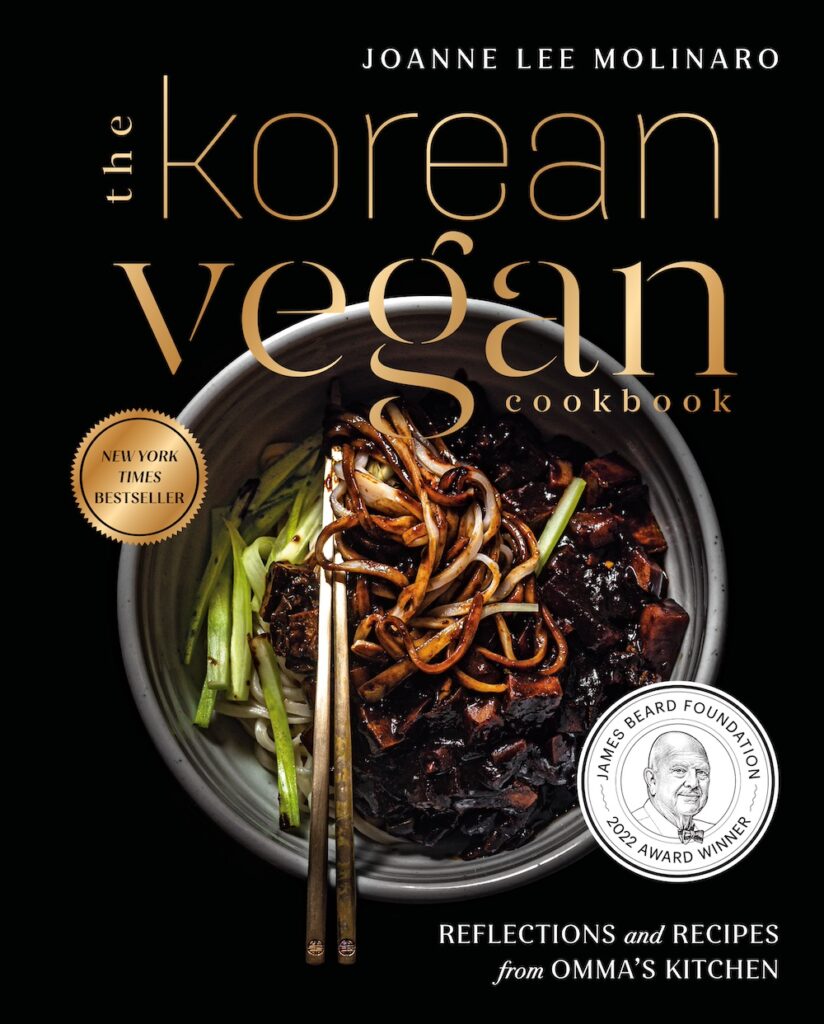
Lovely sponge cake. I halved the sugar and reduced oil by a third, wth no obvious detriment. Soft and pillowy
Hi Joanne! I want to make a “chiffon” cake for my husband on his birthday. I am vegan and he willingly eats vegan with me regularly. He has requested me to make him an orange chiffon cake which of course I want to make vegan. He is also indian and loves doklah! Do you think this would be a good cake base for an orange flavored cake that could fulfill this orange chiffon dream cake of his? He also introduced me to you via your cookbook so it would be lovely to follow one of your recipes!
Thanks and love in advance- G
Okay this is cool! So i made the cake, i added cardamom to the dry ingredients, then added orange zest to the wet ingredients and subbed 60ml of the final milk addition with orange juice. It is so fluffy and tasty. Only thing that happened was the top spilt while steaming a bit and then when i flipped it the top stuck to the plate. but its still salvagable and will add icing! Thank you for the great recipe!
Finally had the chance to make this! I don’t have deep 6″ cake pans so I used 2 shallow pans, which meant splitting the ingredients in half and mixing separately once the first cake cooked. My 2nd layer turned out much better because (and I could not have predicted this) the condensation from the lid was leaking down onto layer 1! Making the top a bit gummy. Still edible but not perfect. When I steamed the 2nd layer, I put a kitchen towel between the pot and lid to prevent condensation drips and it worked like a charm. Also didn’t have soymilk powder, so I used unflavored protein powder (it’s got a similar ish composition) and it turned out great!
I followed the suggested measurements for a chocolate cake (in the comments) but used black sesame powder instead – it turned out amazing! Thank you so much for this recipe 🙂
This cake seems amazing and I am so stoked to try it today! I was wondering if it is possible to make this into a chocolate cake? I’m attempting to veganize my mother’s chocolate cake recipe, and I have yet to find a vegan recipe that doesn’t make the cake heavy and dense. Thanks in advance!
Hi Osh! I’ve never tried making it with cocoa powder, but it should be possible. I’m not sure how chocolate-y you want it, but I’d start by adding 1/4 cup cocoa powder to the dry ingredients and increase the soy milk to 1 1/2 cup (plus the 1/3 topper). Good luck!!
Ooh, thank you for the recipe! I’m going to try it. I wanted to ask, havr you ever tried microwaving the sponge instead of steaming? I imagine you would get similar results in less time? I’m curious, but afraid to try.
hi,
is this recipe for steaming only? can you bake the batter?
Hi Vivian! Yes, this is for steaming only. It is a traditionally Indian recipe and the steaming creates the fluffiest crumb. You can try baking it, but having not tried it myself, I’m not sure how it would turn out. I CAN say, however, that the crumb will likely be quite dense. Still tasty though!
Made this once with a slight tweak and it was amazing! I omitted the soy milk powder, couldn’t tell it was not there. I also had to steam it for about an hour because my “fire” was too low the first time (I work with induction) so I just increased the heat and cook time and it came out so good. I had been looking and trying so many recipes for layer cake and though tasty, having multiple layer always made it too heavy. This is exactly what I was looking for!
I’ll try it again today and flavor it differently 🙂
I can’t wait to try it! Is there a reason why soy milk is split? Can I “buttermilk” the whole amount?
Hey Kimmy! Great question–one that I had myself. Honestly, I haven’t had a chance to try it the way you suggest, but I will say that I watched a LOT of videos on steamed cake and they ALL did this little top off at the end. I think that it helps to make the batter super silky smooth to add milk withOUT curd if that makes sense?
Can you make this with oat flour and vegan butter because I’m allergic to milk and vegetable oil
Hi! Did you mean “Oat Milk” and vegan butter? If so, yes, you can substitute the soy milk and soy milk powder with oat milk and oat milk powder. And yes, you can substitute with non-dairy butter!
Sounds amazing, I can’t wait to try it! How do you think it would do in a rice cooker?
The thing with a rice cooker, at least my rice cooker, is there is NO way to open it once it’s locked in. So, you can’t check on it midway to see how it’s doing or take it out early to avoid over-steaming. I tried to make chana masala once in my ricecooker and it was a TOTAL disaster for that reason!
Just gave it a shot since my rice cooker has a cake setting and it turned out great! 60 minutes in my Zojirushi – a little underdone so I’ll do a little longer next time.